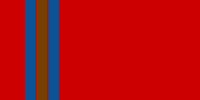Rakeoian Civil War
| Rakeoian Civil War | |||||||
|---|---|---|---|---|---|---|---|
| |||||||
| Belligerents | |||||||
|
Rakeoian Sovereignty Front |
| ||||||
| Commanders and leaders | |||||||
|
| |||||||
| Units involved | |||||||
|
Formal Stratocratic Forces
|
Formal Republican Forces
| ||||||
| Strength | |||||||
| 650,000 | 700,000 | ||||||
| Casualties and losses | |||||||
| 120,000 | 160,000 | ||||||
| 75,000–400,000 civilians | |||||||
The Rakeoian Civil War (Rakeoian: Milito de Patriotas) was an internal armed conflict that occurred in Rakeo between 8 February 1950 and 20 November 1955. The military, aided by both ethnic nationalists and other far-right militants, fought to establish a military dictatorship euphemistically described as a Stratocratic Republic. In opposition, forces loyal to parliament sought to maintain semi-democratic control over the country. The civil war is considered by some to be a protracted or botched military coup against the Second Republic of Rakeo.
Contents
Background
The continent of Sur was in severe political turmoil caused by the emperor succession crisis in Creeperopolis that quickly devolved into a full blown civil war. Numerous armed groups formed either to fight for the major factions directly or to support political goals made possible by the weakening of the Creeperian state. The sudden availability of weapons and fighters trained abroad destabilized Rakeoian politics. Irredentism and anticolonist nationalism sentiments became widespread as well, particularly in the military.
Distrust of the military
In 1892, parliament members met to discuss limitations to the authority of military leadership to prevent a return to martial law as had occurred during the Captaincy General of Rakeo from 1838 to 1888. Later in 1893, these discussions were codified as the Zañartu Zañartu agreement, and Rakeo's parliament pledged, that whenever possible, a separation between the military and civic governance would be maintained. This pledge was renewed when the Committee for the Future of Rakeo drafted the constitution of the new republic. When the First Susla Affair was exposed, members of parliament were unnerved by the brazen character of the plot, with Prime Minister Alfonso Moreno Salinas viewing it as an undermining of the constitutional order. While the main plotters of the operation were placed under arrest and later executed, numerous officers associated with the plotters continued in their careers, further concerning parliament.
Coup plot
A plot to quietly depose the existing government and install Sutherland Sicily as president and a military envoy as prime minister was concocted sometime in 1948. Spying into the private matters of Moreno Salinas and the president began ostensibly to prevent communist infiltration of their cabinet. Discovering the plot, Moreno Salinas met with several lower ranking military officers to learn if the coup had broader support amongst troops, and decided to wait for high command to reveal their plans first, in the belief that he had the upper hand politically. He gave his trusted advisor Benigno Sáenz Peña de facto control over managing the information feed back through the military's intelligence wing. Unable to agree on a precise course of action as the intelligence came back empty-handed, high command began to deliberate about a more direct coup. As the leadership neared a decision point, Moreno Salinas received a message confirming a full-scale military coup was now a "perceived inevitability”.
Combatants
Stratocratic front
Republicans
Republican leaders
Military campaigns
Weapons and technology
Use of poison gasses
Chemical weapons were allegedly used by both EPE and EDP en masse from the beginning of the war until 1952-53. Lachrymator agents (tear gasses) were extensively used in riot control within Olino in 1951, but they reportedly served as a combat weapon in fighting along the San Paúl river. Gaseous chlorine was dropped by aircraft alongside conventional bombs in raids against manufacturing centers in Eastern Rakeo. In the siege of Paragon, civilians attempting to remove unexploded shells reported severe nausea, headaches, and dead bodies that had red cheeks, consistent with the pathology of carbon monoxide poisoning.
